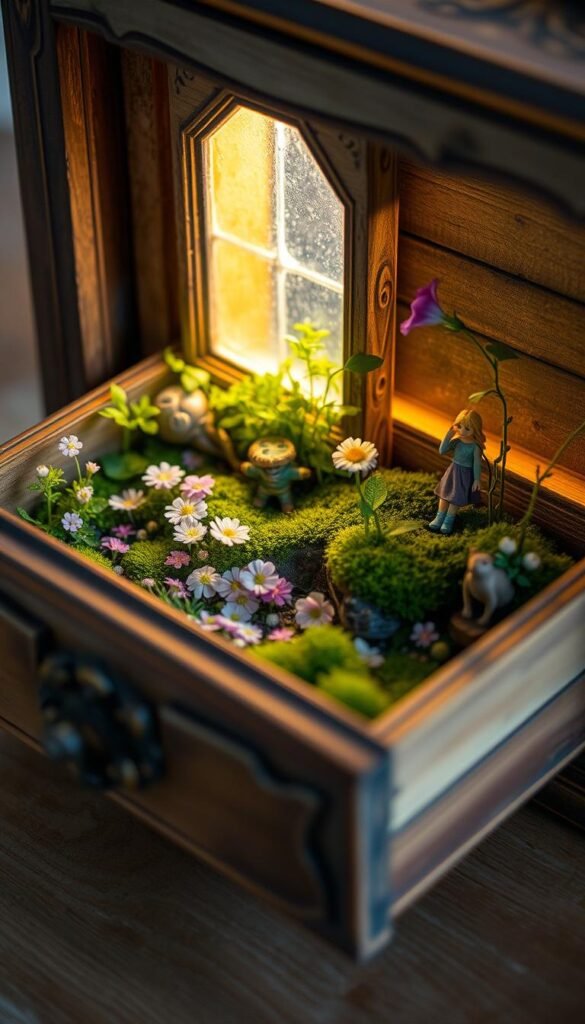Imagine turning forgotten household items into whimsical worlds that spark joy wherever you place them. Portable miniature gardens let you design magical spaces that traditional planting methods can’t replicate. Unlike fixed outdoor setups, these creative projects adapt to your lifestyle, letting you chase sunlight or shelter delicate decorations during storms.
Why choose containers like vintage suitcases or drawers? They’re sturdy, easy to move, and add nostalgic charm to your design. You’ll protect tiny figurines from getting lost while controlling moisture levels for live plants. Best of all, you’re giving discarded objects new purpose – reducing waste while crafting something extraordinary.
This guide reveals how to build enchanting ecosystems that thrive indoors or outdoors. Discover clever ways to arrange moss, stones, and mini accessories into cohesive stories. Learn drainage hacks for healthy greenery and placement tricks to showcase your creation.
Whether you’re a seasoned crafter or new to miniature landscapes, portable designs offer endless creative freedom. They’re perfect for playtime with kids, seasonal displays, or unique home decor. Ready to transform that old trunk in your attic? Let’s begin your journey into sustainable, movable magic.
Understanding the Magic of Portable Fairy Gardens
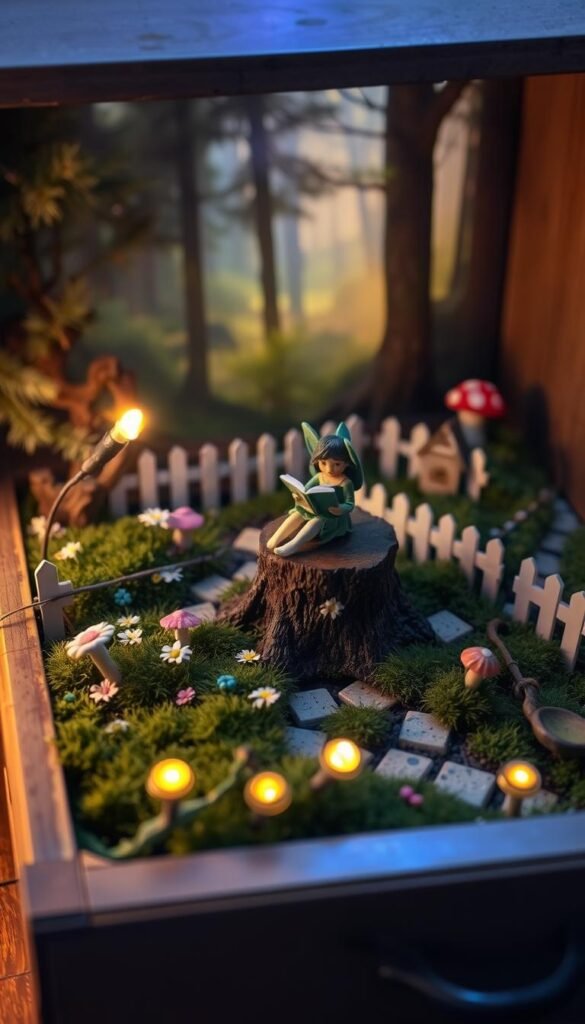
There’s a special kind of wonder in holding an entire universe between your hands. Portable miniature ecosystems become gateways to imagination, blending nature’s beauty with endless storytelling possibilities. Unlike static displays, these movable creations grow with your ideas – today’s mushroom cottage could become tomorrow’s seaside castle.
Why These Tiny Worlds Captivate All Ages
Small world play isn’t just child’s play – it’s a bridge between generations. Adults rediscover childhood wonder while guiding kids through miniature narratives. As one preschool teacher notes: “When families build scenes together, they’re not just arranging pebbles – they’re sharing values through shared creativity.”
Children thrive in these unstructured environments. Without rigid guidelines, they invent rules, solve problems, and express emotions through tiny characters. A study in early childhood development found kids using miniature setups show 30% more complex language patterns during play.
The Art of Miniature Narratives
Every moss patch and twig bench whispers a story waiting to unfold. Portable designs take this further – moving the scene from kitchen table to backyard sparks new plot twists. Yesterday’s forest clearing becomes today’s mountain summit simply by rotating the container.
This fluidity helps young minds grasp abstract concepts. Through movable elements, children learn about change and adaptation. The garden becomes a safe space to explore big feelings, with fairies facing challenges mirroring their own experiences.
Best of all? There’s no permanent mistakes. If a river doesn’t flow right or a bridge collapses, the story simply evolves. This freedom from perfection makes these gardens powerful tools for building creative confidence.
Choosing the Perfect Container for Your Fairy Garden
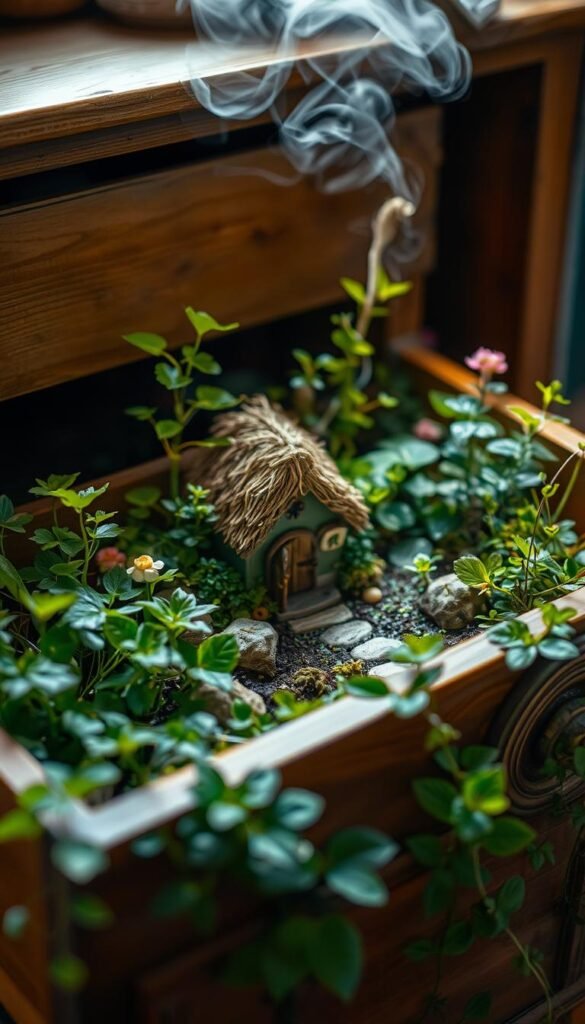
Your container isn’t just a home for plants—it’s the foundation of your miniature ecosystem. Let’s explore how to pick materials that balance charm with practicality while surviving sun, rain, and curious hands.
Finding Hidden Potential in Everyday Objects
Look for containers at least 6 inches deep to support living greenery. Vintage suitcases add retro flair but need extra weatherproofing. Dresser drawers work well indoors, while wheelbarrows handle outdoor conditions better. Consider these popular options:
| Container Type | Best For | Depth | Weather Resistance |
|---|---|---|---|
| Wooden Salad Bowl | Indoor Displays | 5-7″ | Low |
| Fishing Tackle Box | Travel-Friendly | 4-6″ | Medium |
| Galvanized Wheelbarrow | Outdoor Use | 8-12″ | High |
Shielding Your Creation From the Elements
Water damage ruins both containers and plants. Line wooden boxes with plastic sheets, leaving 1/2″ gaps at the bottom for drainage. For suitcases, insert a plastic tray inside—it protects the lining while letting excess moisture escape.
Outdoor setups need 3-5 drainage holes. Place pebbles under soil to prevent clogging. Rotate containers weekly if kept on patios to avoid uneven weathering. As one gardener advises: “Treat your container like a house—strong roof, good plumbing, and regular maintenance.”
Deciding on Your Fairy Garden Theme
The heart of your miniature world lies in the stories you choose to tell. Whether celebrating a family milestone or recreating a favorite vacation spot, your theme breathes life into tiny details. This creative foundation guides every choice, from plant selection to accessory placement, ensuring harmony in your design.
Incorporating Personal Stories and Imagination
Transform memories into magic by weaving meaningful moments into your scene. A child’s first shoe becomes a quirky planter, while seashells from a beach trip form a mystical shoreline. As one designer shares: “The most captivating themes reflect pieces of your life – they spark conversations and nostalgia.”
Popular inspiration sources include:
- Seasonal celebrations (snowy winter villages, autumn harvests)
- Storybook adventures (enchanted forests, dragon lairs)
- Travel memories (Parisian cafes, tropical jungles)
Selecting a Scale and Style That Works for You
Consistent proportions make your world believable. The 1:12 scale (1 inch = 1 real-world foot) works for most containers, letting standard miniatures like portable fairy garden design elements fit perfectly. Smaller 1:24 scales suit intricate scenes in compact spaces like teacups.
Consider these pairings:
| Theme | Ideal Scale |
|---|---|
| Detailed Victorian Home | 1:12 |
| Tiny Beach Cove | 1:24 |
Your style should match both your container’s size and the story you want to tell. Whimsical or realistic? Let your heart guide the vision.
Step-by-Step Guide for Assembling Your Fairy Garden
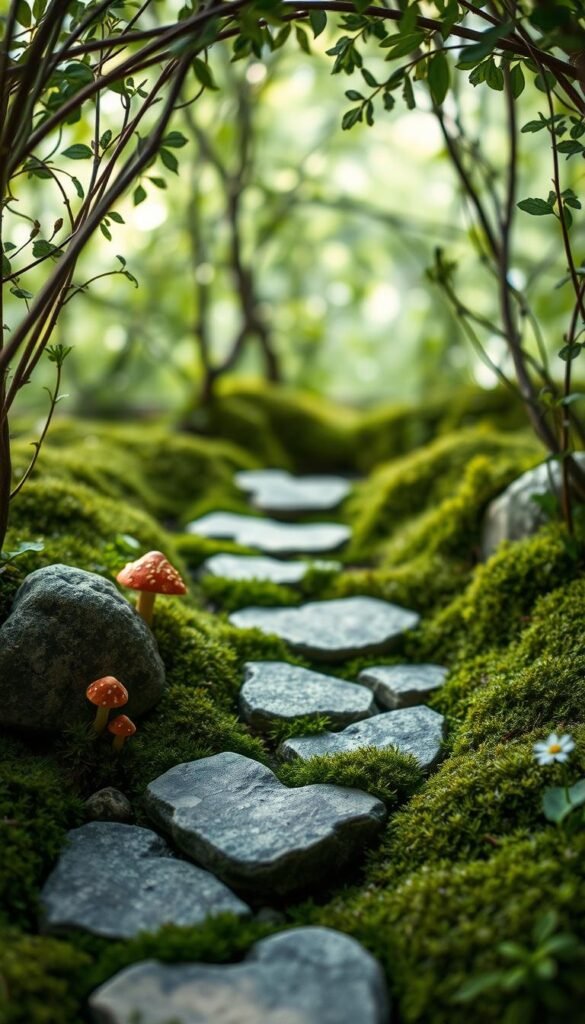
Building your miniature paradise begins with a solid foundation. Let’s break down the process into manageable steps that ensure success, whether you’re working with heirloom trunks or modern storage boxes.
Preparing the Container and Lining It Properly
Start by lining your chosen container with heavy-duty plastic. Trim excess material using scissors, leaving ½” overhang. For outdoor setups, drill 5-7 drainage holes in the bottom. Pro tip: Angle holes slightly downward to prevent soil leakage.
Choose soil based on your plants’ needs. Use potting mix for living greenery or regular soil for artificial arrangements. Fill containers until soil sits 1″ below the rim. This lip prevents spills when moving your creation. As one gardener advises: “Treat your container like a favorite planter – drainage first, beauty second.”
Arranging Your Landscape: From Soil to Miniature Structures
Position your main cottage or tower first. Create winding paths using flat stones spaced 2-3″ apart. For living plants, nestle potted succulents into the soil. Cover exposed areas with preserved moss sheets cut to size.
Work in layers for depth:
- Base: Soil mixed with perlite
- Middle: Decorative rocks & miniature accessories
- Top: Moss or artificial turf
Rotate your container as you work to check visibility from all angles. This simple trick helps you make fairy garden scenes that look complete from every viewpoint. With these techniques, you’ll craft enchanting spaces that evolve over time while staying portable.
Using Natural Elements to Enhance the Scene
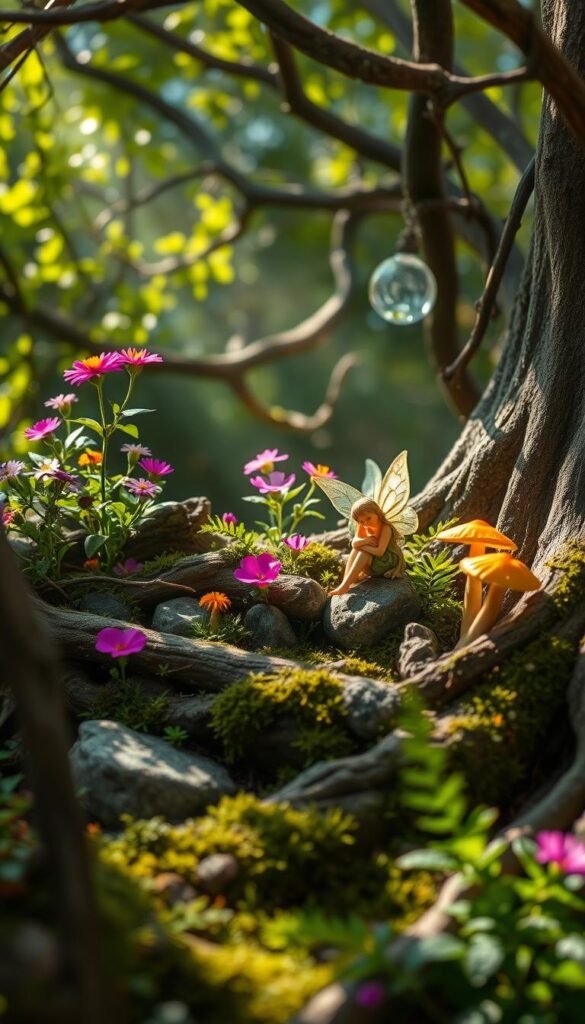
Nature’s smallest treasures hold the power to transform ordinary containers into immersive miniature worlds. By blending textures from the earth itself, you create landscapes that feel authentically alive. These organic materials connect your design to real ecosystems while sparking imaginative play.
Incorporating Moss, Stones, and Sand in Your Design
Moss forms the perfect living carpet for your scene. Press fresh clumps into damp soil for instant greenery, or use preserved sheets for low-maintenance coverage. Mist weekly with distilled water to maintain vibrant color. As one gardener suggests: “Treat moss like a thirsty friend – consistent sips keep it happy.”
Stones add structure and storytelling potential. Create winding pathways using flat river rocks or stack pebbles into miniature walls. Vary sizes for visual interest – larger boulders make striking focal points near tiny cottages.
Sand unlocks endless theme possibilities. Rake white quartz sand into zen patterns or layer colored varieties for beach transitions. Contain it using stone borders to prevent mixing with soil. For desert scenes, mix sand with small succulents that thrive in dry conditions.
Combine these elements using the rule of thirds for balance. Place your largest stone off-center, surround it with moss, then add sand accents. This layered approach creates depth while letting each material shine. Your miniature landscape will feel like a natural extension of the earth itself.
Integrating Miniature Accessories and Plants
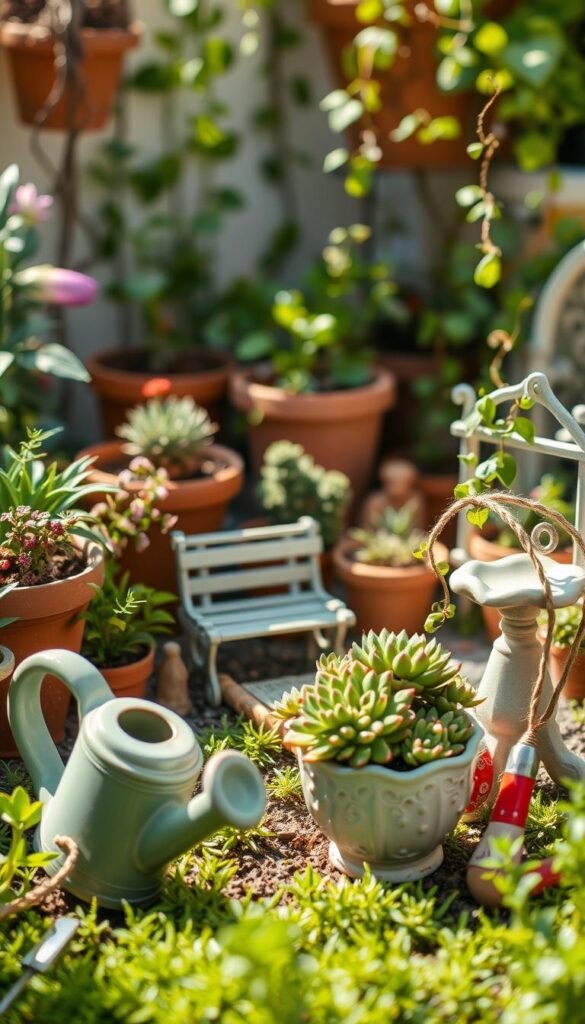
The magic of your miniature world comes alive through thoughtful combinations of living elements and crafted details. Whether you prefer lush greenery or low-maintenance charm, your choices shape both the aesthetic and functionality of your design. Let’s explore how to balance natural beauty with imaginative craftsmanship.
Choosing Between Real and Artificial Miniature Plants
Living plants add authenticity but require careful selection. For indoor setups, try Dwarf Mondo Grass or trailing Baby Tears. Outdoor scenes thrive with hardy options like Platt’s Black Brass Buttons. Artificial alternatives work well in dry climates or busy households.
| Plant Type | Maintenance | Longevity | Best For |
|---|---|---|---|
| Real Plants | Weekly watering | 2-5 years | Natural texture lovers |
| Artificial | Dusting only | 5+ years | Low-effort designs |
DIY Ideas for Crafting Unique Mini Accessories
Transform everyday finds into storybook treasures. Bake polymer clay into mushroom stools or twist wire into arched bridges. One crafter shares: “Acorn caps became perfect fairy bowls when glued to toothpick legs.” Hide store-bought plant pots under moss blankets for seamless integration.
Combine materials creatively:
- Twig fences with pebble pathways
- Bottle-cap ponds lined with blue sand
- Old jewelry parts repurposed as garden gates
These personal touches make your creation truly one-of-a-kind while keeping costs low. Remember – great designs mix purchased pieces with handmade charm.
Optimizing Your Setup for Indoor and Outdoor Enjoyment
Your miniature paradise deserves to shine in any setting. With smart planning, you can enjoy it on sunny patios or cozy windowsills without compromising delicate elements. The key lies in anticipating weather patterns and preparing flexible protection strategies.
Smart Shelter Solutions for Every Season
Wind and water pose the biggest threats to portable designs. Anchor lightweight accessories with clear aquarium glue – it holds strong yet remains invisible. For living plants, use plastic nursery pots buried in soil. This lets you quickly move sensitive greenery indoors when storms hit.
Create a weather-ready container with these materials:
- Marine-grade sealant for wooden surfaces
- Rustproof metal handles for easy carrying
- Adjustable acrylic lid for sudden rain
Rotate outdoor displays weekly to prevent sun damage. As one gardener notes: “Morning light nurtures, afternoon rays scorch – position accordingly.” Pair weather-resistant flowers like colorful container gardening favorites with artificial elements for all-season appeal.
Transition smoothly between environments by timing moves carefully. Shift gardens indoors before temperatures drop below 50°F at night. Use trays with drainage channels to catch water during transport. With these measures, your creation stays vibrant through countless adventures.
Fairy Garden in a Repurposed Drawer or Suitcase: Creating a Portable Scene
Old luggage and forgotten furniture pieces hold untapped potential for crafting enchanting mobile landscapes. Their sturdy frames and built-in handles make relocation effortless, letting you showcase your miniature garden wherever inspiration strikes. A weathered suitcase’s patina adds instant character, while drawers offer modular spaces for layered storytelling.
Transform these containers into thriving ecosystems with simple modifications. Drill ¼-inch drainage holes along the base, spacing them 3 inches apart. Line wooden interiors with waterproof adhesive film to prevent rot. As one crafter notes: “Use lightweight potting mix to keep your setup manageable – nobody wants a herniated disc from moving their fairy world!”
Mobility unlocks creative flexibility. Shift your scene from shaded patios to sunny windowsills to nurture different plants. Rotate seasonal decorations easily – autumn leaves give way to winter wonderlands in minutes. For outdoor use, position containers under covered porches to shield delicate moss from heavy rain.
Manage challenges with smart solutions:
- Attach casters to bulky drawers for smooth rolling
- Spray vintage metal parts with rust-resistant sealant
- Use removable plastic trays for quick accessory swaps
These conversation-starting creations blend nostalgia with functionality. Guests will marvel at how grandma’s old trunk became a thriving miniature home for whimsical creatures. Every scratch and stain tells a story, making your design uniquely yours.
Budget-Friendly Ideas and Cost Saving Tips for Your Fairy Garden
Crafting magical miniature landscapes doesn’t require deep pockets—just creativity and resourcefulness. Start by raiding your home for unused items. Old jewelry becomes glimmering pathways, while mismatched buttons transform into colorful stepping stones. Your garden gains character when you see potential in what others overlook.
Thrift stores and yard sales are treasure troves for affordable accessories. Scan dollhouse sections for tiny furniture, or repurpose toy train set pieces as quirky decorations. One parent shared: “My daughter’s outgrown tea set became a fairy picnic spot—it cost nothing and means everything.”
Nature provides free materials that elevate your design. Collect acorn caps for bowls, twist twigs into fences, and press fallen leaves into roofing shingles. For custom pieces, try molding air-dry clay into mushrooms or benches. These DIY projects spark joy while keeping costs low.
Discover more creative outdoor decor ideas using everyday finds. Remember, the best scenes come from the heart, not the wallet. Let your imagination lead, and watch ordinary objects become extraordinary features in your tiny world.

